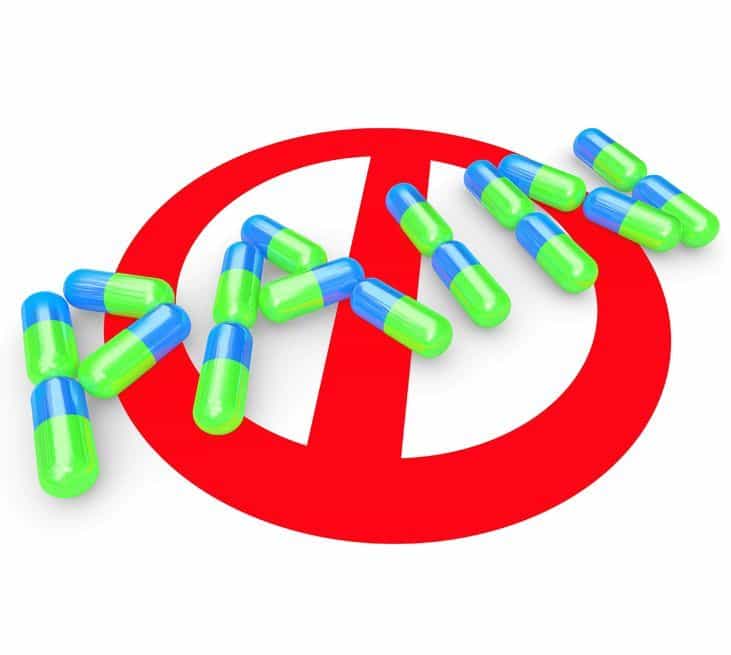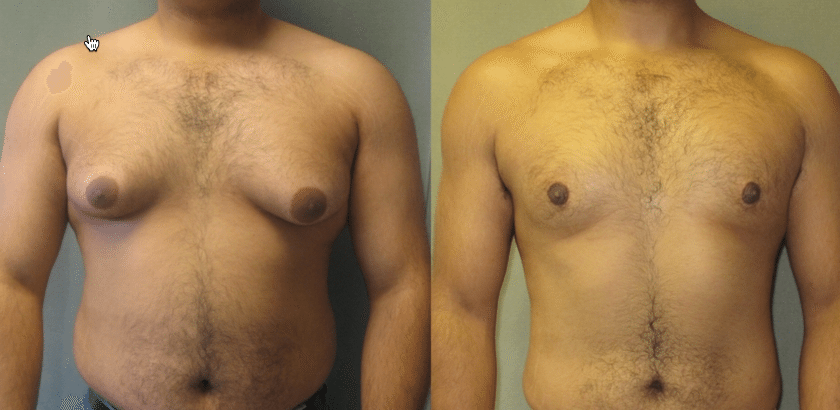
[cmamad id=”3459″ align=”center” tabid=”display-desktop” mobid=”display-desktop” stg=””]
Gynecomastia is a problem that affects more and more men.
Often called “Man boobs,” gynecomastia is a disorder where breast tissue overdevelops in boys and men.
It’s caused by a hormonal imbalance.
Gynecomastia can be painful, but it’s not technically a serious physical health issue.
However, it can be an extreme issue for emotional health.
Nearly all men who have gynecomastia are extremely embarrassed.
These men avoid uncomfortable situations — often this includes avoiding sexual intimacy.
So while it may not be a health hazard, it’s certainly a traumatic issue.
And many of these men want to be able to treat gynecomastia without pills.
Here is a before-and-after picture (not from the study we’re talking about today, but helpful nonetheless:)
The photo on the left shows the man before receiving treatment gynecomastia treatment.
 And there’s a reason that the problem is getting worse.
And there’s a reason that the problem is getting worse.
It comes down to what causes gynecomastia.
Gynecomastia has long been known to be associated with high estrogen levels in men.
 As this study says:
As this study says:
Gynecomastia is believed to arise from peripheral conversion of testosterone to estradiol (a strong form of estrogen) via the enzyme aromatase.
If you’ve been reading my newsletters, you know that men today have way too much estrogen.
But the problem with estrogen is that it’s difficult to measure.
Estrogen tends to hide out in the cells.
So a blood test will not necessarily reveal high estrogen levels.
However, there are situations where it is obvious that estrogen is high.
One of those situations is if you are getting supplemented testosterone.
This includes ALL ways to supplement testosterone — a gel, injection, or pellet.
[cmamad id=”3461″ align=”center” tabid=”display-desktop” mobid=”display-desktop” stg=””]
Testosterone is turned into estrogen in the body through a process called aromatization.
And at least some of the supplemental testosterone is almost always turned into estrogen.
So, it’s for people who supplement testosterone also to get gynecomastia.
But is that ALL that causes gynecomastia?
No.
Gynecomastia is also caused by many other estrogen-related causes.
So if you have “man boobs” even if you’re not taking extra testosterone, the reason is usually high estrogen levels.
This leaves a lot of men looking for how to get rid of gynecomastia.
One gynecomastia treatment involves medications called aromatase inhibitors.
These interfere with the process of turning testosterone into estrogen.
In this study,
We report here our successful experience using medical therapy with the aromatase inhibitor anastrozole (called Arimedix) for the treatment of gynecomastia induced by testosterone replacement therapy in low-T men.
Both of the men given the anastrozole had erectile dysfunction and were taking supplemental testosterone to treat it.
And they developed gynecomastia.
They were each given anastrozole as part of this test.
The patients saw that their “man boobs” diminished — and they continued benefiting from testosterone.
Great news for them!
But what if you have man boobs, but you’re not taking testosterone?
Then you probably have high levels of estrogen in your body for another reason.
There are many reasons for developing high estrogen.
One reason is internal inflammation.
When you have stress hormones causing internal inflammation, estrogen (and prolactin) are often high.
When you have high prolactin and estrogen, you often have erectile dysfunction.
And cells in your breast tissue may respond to the estrogen and prolactin.
This can lead them to become more pronounced, resulting in man boobs.
In some men, they even secrete milk believe it or not!
Another reason for having high estrogen and prolactin is hair loss or prostate medications.
Finasteride is often prescribed for both prostate problems and hair loss.
It has a host of terrible effects, one of which is gynecomastia.
Rogaine is more benign than finasteride but even it can cause gynecomastia.
Then there are foods that cause high estrogen.
Foods high in soy (such as soy milk) are very high in estrogen.
But it’s not just soy beans — any beans are high in estrogens and can result in higher estrogen levels in the body.
If you’re overweight, you have another reason why your estrogen could be high.
Fat cells create their own estrogen.
This is why losing weight by losing fat is a double edged sword.
Although there is a huge plus to fat loss, there is also a huge negative.
The estrogen that is stored in the fat cells is released when you burn off fat.
This floods your body with estrogen and can cause gynecomastia symptoms to get worse.
But gynecomastia isn’t the only result of all of this estrogen.
There’s a huge tie in between high estrogen levels and erectile dysfunction.
Most men have reasonably high testosterone levels.
But high estrogen often causes performance problems.
High estrogen is associated with a lot of other issues as well.
So you really want to find a way to get rid of your excess estrogen.
You can talk to your doctor about a medication treatment for gynecomastia.
It’s quite possible that if you have high estrogen levels you may benefit from one of these aromatase inhibitors — such as anastrozole.
There are other options as well.
What if you want a natural approach to slashing estrogen?
There are some powerful natural aromatase inhibitors, including aspirin, methylene blue, and vitamin E.

http://www.nature.com/ijir/journal/v16/n1/abs/3901154a.html
